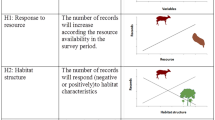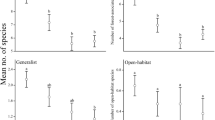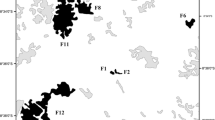Abstract
Urbanization generally reduces wildlife populations. Individual species responses, however, are often highly variable, and such variability can be explained by differences in species ecological traits. To examine this hypothesis, we focused on two co-occurring land snails, Ezohelix gainesi and Euhadra brandtii sapporo; the former is ground-dwelling and the latter is arboreal. We first estimated their population densities at nine sites distributed along an urbanization gradient: three were located in continuous natural forests, three at the edge of natural forests, and the rest in small isolated forests in urban areas. As a result, the ground-dwelling E. gainesi occurred at highest density in urban forests, followed by forest edges and continuous forests. By contrast, the arboreal E. b. sapporo occurred at highest density in continuous forests, but declined in forest edges and urban forests. We then conducted manipulative field experiments to quantify changes in predation pressure on these species. Ground-tethered E. gainesi and E. b. sapporo were repeatedly predated upon by forest-living mammals in continuous forests, but their survival rates increased in forest edges and urban forests. By contrast, canopy-tethered E. b. sapporo maintained high survival rates in all three forest types. The results indicate that a lack of mammalian predators enables ground-dwelling species to occur at high densities in urban forests, whereas the arboreal species was not affected by this predator relaxation effect. The combination of species-specific behavioural traits and changes in predator communities across an urbanization gradient has important effects on the biodiversity of urban ecosystems.






Similar content being viewed by others
Change history
03 March 2020
The original version of the article unfortunately contained mistakes in the legends of Fig. 3. The legends (1) Blue square: <Emphasis Type="Italic">Euhadra brandtii sapporo</Emphasis>, ground is changed to Blue square: <Emphasis Type="Italic">Euhadra brandtii sapporo</Emphasis>, canopy (2) Red circle: <Emphasis Type="Italic">Euhadra brandtii sapporo</Emphasis>, canopy is changed to Red circle: <Emphasis Type="Italic">Euhadra brandtii sapporo</Emphasis>, ground.
References
Crooks KR, Soulé ME (1999) Mesopredator release and avifaunal extinctions in a fragmented system. Nature 400:563–566
Ehlers Smith YC, Ehlers Smith DA, Ramesh T, Downs CT (2018) Forest habitats in a mixed urban-agriculture mosaic landscape: patterns of mammal occupancy. Landsc Ecol 33:59–76
El-Sabaawi R (2018) Trophic structure in a rapidly urbanizing planet. Funct Ecol 32:1718–1728
Faeth SH, Warren PS, Shochat E, Marussich WA (2005) Trophic dynamics in urban communities. BioScience 55:399–407
Fischer JD, Cleeton SH, Lyons TP, Miller JR (2012) Urbanization and the predation paradox: the role of trophic dynamics in structuring vertebrate communities. BioScience 62:809–818
Fox GA (2001) Future-time analysis. In: Scheiner SM, Gurevitch J (eds) Design and analysis of ecological experiments. Oxford University Press, New York, pp 235–266
Gagné SA, Fahrig L (2011) Do birds and beetles show similar responses to urbanization? Ecol Appl 21:2297–2312
Gallo KP, Owen TW (1999) Satellite-based adjustments for the urban heat island temperature bias. J Appl Meteorol 38:806–813
Gering JC, Blair RB (1999) Predation on artificial bird nests along an urban gradient: predatory risk or relaxation in urban environments? Ecography 22:532–541
Groombridge B, Jenkins MD (2002) World atlas of biodiversity. UNEP World Conservation Monitoring Centre, Berkeley
Hansen AJ, Knight RL, Marzluff JM, Powell S, Brown K, Gude PH, Jones K (2005) Effects of exurban development on biodiversity: patterns, mechanisms, and research needs. Ecol Appl 15:1893–1905
Hodges MN, McKinney ML (2018) Urbanization impacts on land snail community composition. Urban Ecosyst 21:721–735
Horsák M, Lososová Z, Čejka T, Juřičková L, Chytrý M (2013) Diversity and biotic homogenization of urban land-snail faunas in relation to habitat types and macroclimate in 32 central European cities. PLoS One 8:e71783
Ishii H (2000) Canopy research using single-rope techniques in the temperate coniferous forests of the Pacific northwest, USA. Japanese Journal of Ecology 50:65–70 (in Japanese)
Kalnay E, Cai M (2003) Impact of urbanization and land-use change on climate. Nature 423:528
Kissick AL, Dunning JB Jr, Fernandez-Juricic E, Holland JD (2018) Different responses of predator and prey functional diversity to fragmentation. Ecol Appl 28:1853–1866
Konuma J, Nagata N, Chiba S (2011) Factors determining the direction of ecological specialization in snail-feeding carabid beetles. Evolution 65(2):408–418
Lättman H, Bergman KO, Rapp M, Tälle M, Westerberg L, Milberg P (2014) Decline in lichen biodiversity on oak trunks due to urbanization. Nord J Bot 32:518–528
Lowman MD, Schowalter TD, Franklin JF (2012) Methods in Forest canopy research. University of California Press, Berkeley
Lydeard C, Cowie RH, Ponder WF, Bogan AE, Bouchet P, Clark SA, Cummings KS, Frest TJ, Gargominy O, Herbert DG, Hershler R, Perez KE, Roth B, Seddon M, Strong EE, Thompson FG (2004) The global decline of nonmarine mollusks. BioScience 54:321–330
Martinson HM, Raupp MJ (2013) A meta-analysis of the effects of urbanization on ground beetle communities. Ecosphere 4:art60
Marzluff JM (2005) Island biogeography for an urbanizing world: how extinction and colonization may determine biological diversity in human-dominated landscapes. Urban Ecosyst 8:157–177
Mason CF (1970) Snail populations, beech litter production, and the role of snails in litter decomposition. Oecologia 5:215–239
McDonnell MJ, Hahs AK (2008) The use of gradient analysis studies in advancing our understanding of the ecology of urbanizing landscapes: current status and future directions. Landsc Ecol 23:1143–1155
McKinney ML (2002) Urbanization, biodiversity, and conservation: the impacts of urbanization on native species are poorly studied, but educating a highly urbanized human population about these impacts can greatly improve species conservation in all ecosystems. BioScience 52:883–890
Miyashita T, Shinkai A, Chida T (1998) The effects of forest fragmentation on web spider communities in urban areas. Biol Conserv 86:357–364
Morii Y, Prozorova L, Chiba S (2016) Parallel evolution of passive and active defence in land snails. Sci Rep 6:35600
Oishi Y (2018) Urban heat island effects on moss gardens in Kyoto. Japan Landscape and Ecological Engineering 15:177–184. https://doi.org/10.1007/s11355-018-0356-z
Oksanen J, Guillaume Blanchet F, Friendly M, Kindt R, Legendre P, McGlinn D, Minchin PR, O'Hara RB, Simpson GL, Solymos P, Stevens MHH, Szoecs E, Wagner H. (2019) Package 'vegan'. https://cran.r-project.org/web/packages/vegan/vegan.pdf
Patten MA, Bolger DT (2003) Variation in top-down control of avian reproductive success across a fragmentation gradient. Oikos 101:479–488
R Core Team (2018) R: a language and environment for statistical computing. R Foundation for Statistical Computing, Vienna, Austria
Riley SPD, Busteed GT, Kats LB, Vandergon TL, Lee LFS, Dagit RG, Kerby JL, Fisher RN, Sauvajot RM (2005) Effects of urbanization on the distribution and abundance of amphibians and invasive species in Southern California streams. Conserv Biol 19:1894–1907
Ritchie EG, Johnson DN (2009) Predator interactions, mesopredator release and biodiversity conservation. Ecol Lett 12:982–998
Rodewald AD, Kearns LJ, Shustack DP (2011) Anthropogenic resource subsidies decouple predator–prey relationships. Ecol Appl 21:936–943
Saeki I (2015) Conservation biology at field research stations: five potential roles in forest ecosystem management. Biodiversity 16:42–46
Saeki I, Niwa S, Osada N, Hyodo F, Ohta T, Oishi Y, Hiura T (2017a) Adaptive significance of arboreality: field evidence from a tree-climbing land snail. Anim Behav 127:53–66
Saeki I, Niwa S, Osada N (2017b) Predation of a rare arboreal land snail Euhadra brandtii sapporo by introduced common raccoon Procyon lotor. Venus: Japanese Journal of Malacology 75:83–87
Saito M, Koike F (2013) Distribution of wild mammal assemblages along an urban–rural–forest landscape gradient in warm-temperate East Asia. PLoS One 8:e65464
Shochat E, Warren PS, Faeth SH, McIntyre NE, Hope D (2006) From patterns to emerging processes in mechanistic urban ecology. Trends Ecol Evol 21:186–191
Shochat E, Lerman SB, Anderies JM, Warren PS, Faeth SH, Nilon CH (2010) Invasion, competition, and biodiversity loss in urban ecosystems. BioScience 60:199–208
Yang P, Ren G, Hou W (2017) Temporal–spatial patterns of relative humidity and the urban dryness island effect in Beijing City. J Appl Meteorol Climatol 56:2221–2237
Acknowledgments
We sincerely thank Dr. T. Nakaji, Dr. H. Ishii, Dr. K. Nakai, Dr. A. Agetsuma, Dr. O. Kishida, Dr. Y. Okuzaki, Ms. R. Uchida, Mr. J. Uchida, Mr. A. Okuda, Mr. Y. Sasabe, Mr. W. Mukaimine, and staff members of the Tomakomai city government, the Hokkaido Prefectural government, and the Nihon-seishi Corporation for their support. This research was funded by the Japan Society for Promotion of Sciences (grant no. 17 K07270).
Author information
Authors and Affiliations
Contributions
IS, SN, and NO designed research, collected and analysed data, and wrote the manuscript. WA and TH collected data and revised the manuscript. All authors contributed critically the drafts and gave final approval for publication
Corresponding author
Electronic supplementary material
ESM1
(DOCX 2.16 MB)
Rights and permissions
About this article
Cite this article
Saeki, I., Niwa, S., Osada, N. et al. Contrasting effects of urbanization on arboreal and ground-dwelling land snails: role of trophic interactions and habitat fragmentation. Urban Ecosyst 23, 603–614 (2020). https://doi.org/10.1007/s11252-020-00930-6
Published:
Issue Date:
DOI: https://doi.org/10.1007/s11252-020-00930-6




